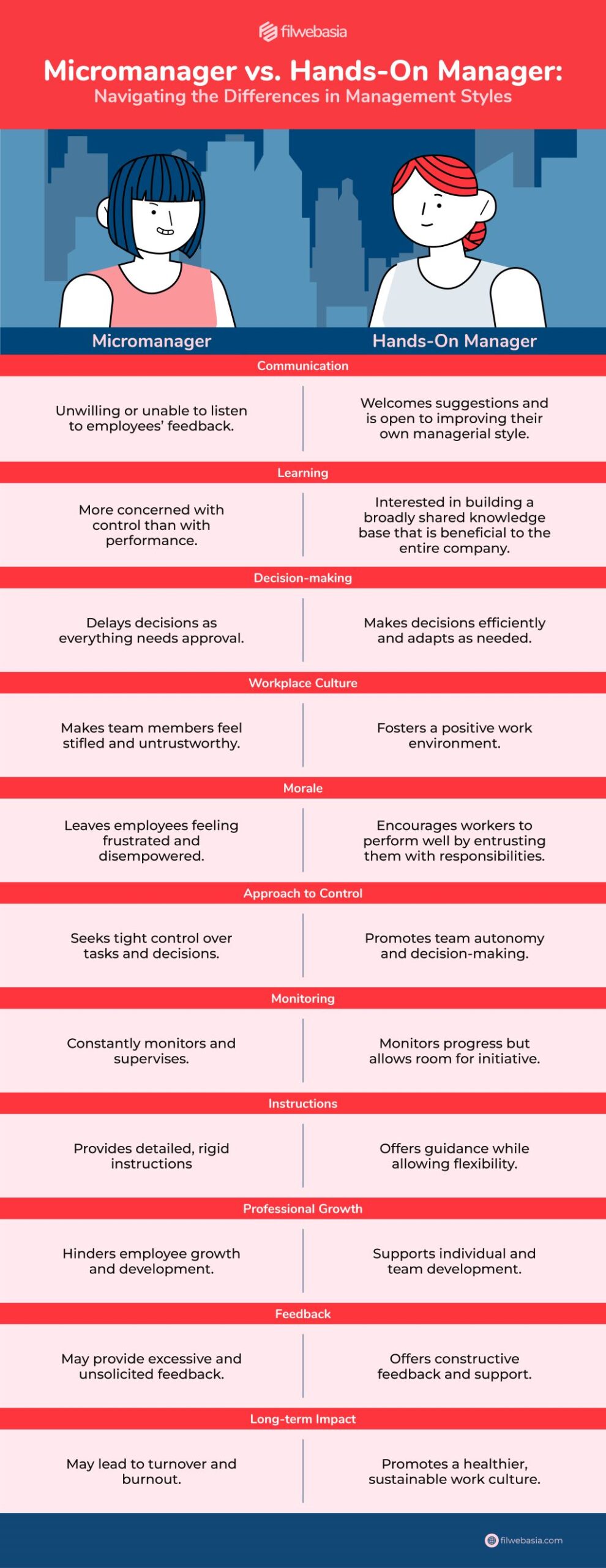Managers play a vital role in ensuring that companies achieve their goals. They have different ways of leading a team. Some of them let employees perform tasks independently. However, there are leaders who take part in the nitty-gritty of the business functions a little too much, leading to micromanagement.
If you want to know how to deal with a micromanager, or are simply interested in learning more about micromanagement, you’re on the right page! Not to boss around, but you’ve got to read this one.
What is Micromanagement?
Micromanagement happens when a manager works with the team while closely monitoring their performance and output, leaving little room for autonomy or creativity. One can characterize this management style by excessive control, scrutiny, and intervention in an employee’s work. This approach can stifle productivity, demotivate employees, and hinder the growth of both the individual and the organization.

Micromanager vs. Hands-On Manager
Before we delve into strategies on how to deal with a micromanager, it’s important to distinguish between a micromanager and a hands-on manager. While both types of leaders are deeply involved in their team’s work, a hands-on manager typically provides guidance and support, encouraging growth and learning. A micromanager, on the other hand, tends to focus on control and minute details, often at the expense of creativity and individual development.
Aside from that, there’s a fine line between the two when it comes to various aspects of work and office culture.
Micromanagers
- Micromanagers have an insatiable desire for control over every aspect of a project or task.
- Most of the time, they resort to tracking every step of the process.
- These managers provide highly detailed instructions, leaving little room for interpretation.
- They may believe that no one can complete a task as well as they can, leading to a lack of delegation.
- With their need for control, micromanagers can slow down decision-making processes, as all decisions must pass through them for approval.
Hands-on Managers
- Hands-on managers see themselves as coaches rather than taskmasters.
- They provide high-level objectives and trust their team to make decisions and solve problems.
- While hands-on managers play an active role, they maintain a balance between providing guidance and allowing their team members the freedom to execute tasks in their own way.
- They value diverse perspectives and ideas and thus openly encourage experimenting with new approaches.

Download our infographic about the difference between a micromanager and a hands-on manager.
What Causes Micromanagement at Work?
A variety of factors, both related to the manager’s personality and external circumstances within the organization, can trigger micromanagement in the workplace. Understanding these underlying causes is essential for addressing and mitigating this issue effectively.
Here are some common reasons behind micromanagement.
Lack of Trust
Micromanagers often have difficulty trusting their employees’ abilities. This lack of trust might be a byproduct of past experiences, where their delegation of tasks resulted in disappointments or even failures.
Fear of Failure
Managers who fear that their team’s mistakes reflect poorly on them may resort to micromanagement to avoid any potential errors.
Perfectionism
Perfectionist managers have a strong desire for everything to be flawless. They may believe that only they can achieve this level of perfection and, therefore, closely oversee every detail.
Insecurity
Insecure managers may use micromanagement as a way to exert control over their team and maintain a sense of superiority. They might feel threatened by competent and independent employees.
Pressure from Superiors
Managers higher up in the hierarchy might exert pressure on middle managers to ensure the flawless execution of all projects. This can lead to micromanagement as middle managers try to meet these expectations.
Organizational Culture
Some workplaces have a culture that inadvertently promotes micromanagement. If upper management sets a precedent of closely monitoring employees, it can trickle down through the organization.
Lack of Training
Managers with inadequate training in leadership and delegation may resort to micromanagement because they are unsure of how to empower their team effectively.
Past Successes with Micromanagement
In some cases, micromanagers may have experienced past successes when using this approach. They might attribute their previous achievements to their micromanagement style and continue with it, even when it’s no longer necessary.

Signs You’re Working with a Micromanaging Boss
Micromanagement is possible to spot with all the red flags. Thus, it’s essential to pay attention to these signs. Moreover, identifying whether you’re dealing with one is the first step in coming up with strategies on how to deal with a micromanager. Look out for these telltale signs:
Constant Oversight
A micromanager may always be hovering, monitoring your progress, and providing unsolicited feedback.
Lack of Autonomy
You have minimal decision-making authority, and even small decisions require approval.
Detailed Instructions
Your boss provides excessively detailed instructions for even the simplest tasks.
Frequent Check-Ins
Micromanagers schedule frequent check-in meetings to track your work’s progress.
Fear-Based Management
You feel a constant sense of pressure, fear, or anxiety in your interactions with your boss.
How to Deal with a Micromanager
Dealing with a micromanager can be challenging, but it’s possible to navigate this situation effectively by employing strategies that promote open communication while maintaining professionalism. Here’s a step-by-step guide on how to deal with a micromanager.
1. Reflect on your work ethic.
Before taking any action, reflect on your own work habits and communication style. Ensure that you’re meeting deadlines, providing regular updates, and taking accountability over your tasks.
2. Understand their perspective.
Try to understand your micromanager’s motivations and concerns. Are they driven by a fear of failure, a need for control, or external pressures? This understanding can help you tailor your approach.
3. Initiate conversation.
Talk to your manager to express your desire for more freedom and responsibility. Emphasize your commitment to achieving shared goals.
4. Set clear expectations.
Ensure that you and your manager have a clear understanding of your roles, responsibilities, and project objectives. This can help reduce the need for constant supervision.
5. Share your progress.
Share regular updates on your progress and achievements to reassure your micromanager that you’re on top of your tasks.
6. Seek feedback.
Ask for feedback on your work and express your willingness to address concerns or improve. This demonstrates your commitment to growth and excellence.
7. Build trust.
Show your competence and reliability over time to rebuild your manager’s trust in your abilities. Deliver consistently high-quality work.
8. Be patient.
Changing a micromanager’s behavior may take time. Stay patient and persistent in your efforts to gain more autonomy and trust.
9. Document everything.
Keep records of your work, decisions, and accomplishments. This can provide evidence of your competence and help resolve disputes.
10. Seek support.
If the situation doesn’t improve, consider seeking support from HR or a higher-level manager to address the issue.
Remember that change may not happen overnight, and that you may have to persist in your efforts to reduce micromanagement gradually. The goal is to create a more collaborative and trusting work relationship while maintaining professionalism and achieving your professional objectives.

Experience a Supportive Workplace that Values Your Skills and Capabilities
Understanding micromanagement, recognizing the signs, and employing effective communication and coping strategies are keys to how to deal with a micromanager. By addressing the issue proactively and professionally, you can foster a healthier working relationship with a micromanaging boss and enhance your own professional growth.
Thankfully, there are organizations that support employees’ career growth and build a healthy community of professionals. If you want to be part of a workplace that promotes collaboration and work-life balance, you don’t need to look elsewhere!
We are in search of professionals who can work independently and can be our allies in providing reliable and expert virtual assistance services. At FilWeb Asia, our supportive environment is built on the belief that our employees are our greatest asset.
Be part of our growing team, and be ready to enjoy a fulfilling, successful career!









